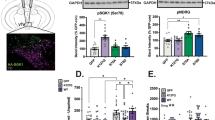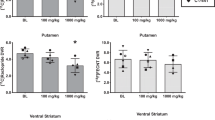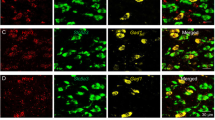Abstract
Previously, we have shown that systemic administration of the 5-HT2C receptor agonist Ro60-0175 reduces cocaine-induced locomotor activity and cocaine self-administration. Ro60-0175 also alters the activity of midbrain dopamine (DA) neurons of the ventral tegmental area (VTA), a region where 5-HT2C receptors are expressed. The present experiments investigated whether microinjections of Ro60-0175 into the VTA would alter the locomotor stimulant effect of cocaine and cocaine self-administration. In the tests for locomotor activity injection of 3 and 10, but not 1 μg, Ro60-0175 into the VTA reduced the locomotor stimulation resulting from injection of 10 mg/kg cocaine. In tests of cocaine self-administration, rats were trained to lever press for intravenous infusions of 0.25 mg cocaine delivered on either a fixed ratio 5 (FR5) or a progressive ratio schedule. Intra-VTA injection of Ro60-0175 at doses of 3 and 10 μg reduced responding for cocaine on both schedules without significantly altering the latency to initiate responding or the rate of responding. A subsequent experiment determined that the suppressant effect of intra-VTA Ro60-0175 (3 μg) on responding for cocaine was prevented by pretreatment with the selective 5-HT2C receptor antagonist SB242,084 (0.5 mg/kg). In a final experiment, intra-VTA injection of Ro60-0175 reduced responding for food reinforcement on the same progressive ratio schedule as used for cocaine self-administration. These results demonstrate that stimulation of 5-HT2C receptors in the VTA is sufficient to attenuate the stimulant and reinforcing effects of cocaine. These effects complement electrophysiological and neurochemical findings, and indicate that 5-HT2C receptors localized within the VTA modulate the activity of mesolimbic DA neurons.
Similar content being viewed by others
Log in or create a free account to read this content
Gain free access to this article, as well as selected content from this journal and more on nature.com
or
References
Abramowski D, Rigo M, Duc D, Hoyer D, Staufenbiel M (1995). Localization of the 5-hydroxytryptamine 2C protein in human and rat brain using specific antisera. Neuropharmacology 34: 1636–1645.
Arnold JM, Roberts DCS (1997). A critique of fixed and progressive ratio schedules used to examine the neural substrates of drug reinforcement. Pharmacol Biochem Behav 57: 441–447.
Bankson MG, Cunningham KA (2001). 3,4-Methylenedioxymethamphetamine (MDMA) as a unique model of serotonin receptor function and serotonin-dopamine interactions. J Pharmacol Exp Ther 297: 846–852.
Barnes NM, Sharp T (1999). A review of central 5-HT receptors and their function. Neuropharmacology 38: 1083–1152.
Boess FG, Martin IL (1994). Molecular biology of 5-HT receptors. Neuropharmacology 33: 275–317.
Brebner K, Phelan R, Roberts DCS (2000a). Effect of baclofen on cocaine self-administration in rats reinforced under fixed-ratio 1 and progressive-ratio schedules. Psychopharmacology 148: 314–321.
Brebner K, Phelan R, Roberts DCS (2000b). Intra-VTA baclofen attenuates cocaine self-administration on a progressive ratio schedule of reinforcement. Pharmacol Biochem Behav 66: 857–862.
Brown CM, Fletcher PJ, Coscina DV (1999). Increased progressive ratio responding after intrahypothalamic neuropeptide Y is not mediated by dopamine. Peptides 19: 1667–1673.
Caine SB, Heinrichs SC, Coffin VL, Koob GF (1995). Effects of the dopamine D-1 antagonist SCH 23390 microinjected into the accumbens, amygdala or striatum on cocaine self-administration in the rat. Brain Res 692: 47–56.
Carroll ME, Lac ST, Asencio M, Kragh R (1990). Fluoxetine reduces intravenous cocaine self-administration in rats. Pharmacol Biochem Behav 35: 237–244.
Corrigall WA, Coen KM, Adamson KL, Chow BL, Zhang J (2000). Response of nicotine self-administration in the rat to manipulations of mu-opioid and gamma-aminobutyric acid receptors in the ventral tegmental area. Psychopharmacology 149: 107–114.
Cussac D, Newman-Tancredi A, Quentric Y, Carpentier N, Poissonnet G, Parmentier JG et al (2002). Characterization of phospholipase C activity at h5-HT2C compared with h5-HT2B receptors: influence of novel ligands upon membrane-bound levels of [3H]phosphatidylinositols. Naunyn Schmiedebergs Arch Pharmacol 365: 242–252.
Dekeyne A, Girardon S, Millan MJ (1999). Discriminative stimulus properties of the novel serotonin 5-HT2C receptor agonist, Ro 60-0175: a pharmacological analysis. Neuropharmacology 38: 415–423.
Depoortere RY, Li DH, Lane JD, Emmett-Oglesby MW (1993). Parameters of self-administration of cocaine in rats under a progressive ratio schedule. Pharmacol Biochem Behav 45: 539–548.
Di Ciano P, Coury A, Depoortere RY, Egilmez Y, Lane JD et al (1995). Comparison of changes in extracellular dopamine concentrations in the nucleus accumbens during intravenous self-administration of cocaine or D-amphetamine. Behav Pharmacol 6: 311–322.
Di Giovanni G, Di Matteo V, La Grutta V, Esposito E (2001). m-Chlorophenylpiperazine excites non-dopaminergic neurons in the rat substantia nigra and ventral tegmental area by activating serotonin-2C receptors. Neuroscience 103: 111–116.
Di Matteo V, Cacchio M, Di Giulio C, Esposito E (2002). Role of serotonin2C receptors in the control of brain dopaminergic function. Pharmacol Biochem Behav 71: 727–734.
Di Matteo V, Di Giovanni G, Di Mascio M, Esposito E (1999). SB242,084 a selective serotonin2C receptor antagonist, increases dopaminergic transmission in the mesolimbic system. Neuropharmacology 38: 1195–1205.
Di Matteo V, Di Giovanni G, Di Mascio M, Esposito E (2000). Biochemical and electrophysiological evidence that Ro60–0175 inhibits mesolimbic dopaminergic function through serotonin2C receptors. Brain Res 865: 85–90.
Eberle-Wang K, Mikeladze Z, Uryu K, Chesselet MF (1997). Pattern of expression of serotonin2C receptor messenger RNA in the basal ganglia of adult rats. J Comp Neurology 384: 233–247.
Filip M, Cunningham KA (2002). Serotonin 5-HT2C receptors in nucleus accumbens regulate expression of the hyperlocomotive and discriminative stimulus effects of cocaine. Pharmacol Biochem Behav 71: 745–756.
Fletcher PJ, Grottick AJ, Higgins GA (2002). Differential effects of the 5-HT2A receptor antagonist M100,907 and the 5-HT2C receptor antagonist SB242,084 on cocaine-induced locomotor activity, cocaine self-administration and cocaine-induced reinstatement of responding. Neuropsychopharmacology 27: 576–586.
Gobert A, Rivet JM, Lejeune F, Newman-Tancredi A, Adhumeau-Auclair A, Nicolas JP et al (2000). Serotonin2C receptors tonically suppress the activity of mesocortical dopaminergic and adrenergic, but not serotonergic, pathways: a combined dialysis and electrophysiological analysis in the rat. Synapse 36: 205–221.
Goeders NE, Smith JE (1983). Cortical dopaminergic involvement in cocaine reinforcement. Science 221: 773–775.
Grottick AJ, Corrigall WA, Higgins GA (2001). Activation of 5-HT2C receptors reduces the locomotor and rewarding effects of nicotine. Psychopharmacology 157: 292–298.
Grottick AJ, Fletcher PJ, Higgins GA (2000). Studies to investigate the role of 5-HT2C receptors on cocaine- and food-maintained behavior. J Pharmacol Exp Ther 295: 1183–1191.
Higgins GA, Fletcher PJ Serotonin and drug reward: focus on 5-HT2C receptors. Eur J Pharmacol (in press).
Hodge CW, Haraguchi M, Chappelle AM, Samson HH (1996). Effects of ventral tegmental microinjections of the GABAA agonist muscimol on self-administration of ethanol and sucrose. Pharmacol Biochem Behav 53: 971–977.
Hoyer D, Hannon JP, Martin GR (2002). Molecular, pharmacological and functional diversity of 5-HT receptors. Pharmacol Biochem Behav 71: 533–554.
Kennett GA, Wood MD, Bright F, Trail B, Riley G, Holland V et al (1997). SB242,084, a selective and brain penetrant 5-HT2C receptor antagonist. Neuropharmacology 36: 609–620.
Loh EH, Roberts DCS (1990). Break points on a progressive ratio schedule reinforced by intravenous cocaine increase following depletion of forebrain serotonin. Psychopharmacology 101: 262–266.
Martin JR, Bos M, Jenck F, Moreau J-L, Mutel V, Sleight AJ et al (1998). 5-HT2C receptor agonists: pharmacological characteristics and therapeutic potential. J Pharmacol Exp Ther 286: 913–924.
McCreary AC, Cunningham KA (1999). Effects of the 5-HT2C/2B antagonist SB 206553 on hyperactivity induced by cocaine. Neuropsychopharmacology 20: 556–564.
McGregor A, Lacosta S, Roberts DCS (1993). L-Tryptophan decreases the breaking point under a progressive ratio schedule of intravenous cocaine reinforcement in the rat. Pharmacol Biochem Behav 44: 651–655.
McGregor A, Roberts DCS (1993). Dopaminergic antagonism within the nucleus accumbens or the amygdala produces differential effects on intravenous cocaine self-administration under fixed and progressive ratio schedules of reinforcement. Brain Res 624: 245–252.
McGregor A, Roberts DCS (1995). Effect of medial prefrontal cortex injections of SCH 23390 on intravenous cocaine self-administration under both a fixed and progressive ratio schedule of reinforcement. Behav Brain Res 67: 75–80.
Oakley NR, Hayes AG, Sheehan MJ (1991). Effect of typical and atypical neuroleptics on the behavioural consequences of activation by muscimol of mesolimbic and nigro-striatal dopaminergic pathways in the rat. Psychopharmacology 105: 204–208.
Pellegrino LJ, Pellegrino AS, Cushman AJ (1979). A Stereotaxic Atlas of the Rat Brain 2nd edn. Plenum Press: New York and London.
Pettit HO, Justice JB (1991). Effect of dose on cocaine self-administration behavior and dopamine levels in the nucleus accumbens. Brain Res 539: 94–102.
Pompeiano M, Palacios JM, Mengod G (1994). Distribution of the serotonin 5-HT2 receptor family mRNAs: comparison between 5-HT2A and 5-HT2C receptors. Mol Brain Res 23: 163–178.
Richardson NR, Roberts DCS (1991). Fluoxetine pretreatment reduces breaking points on a progressive ratio schedule reinforced by intravenous cocaine self-administration in the rat. Life Sci 49: 833–840.
Richardson NR, Roberts DCS (1996). Progressive ratio schedules in drug self-administration studies in rats: a method to evaluate reinforcing efficacy. J Neurosci Methods 66: 1–11.
Roberts DC, Andrews MM, Vickers GJ (1996). Baclofen attenuates the reinforcing effects of cocaine in rats. Neuropsychopharmacology 15: 417–423.
Roberts DCS, Koob GF, Klonoff P, Fibiger HC (1980). Extinction and recovery of cocaine self-administration following 6-hydroxydopamine lesions of the nucleus accumbens. Pharmacol Biochem Behavior 12: 781–787.
Robledo P, Koob GF (1993). Two discrete nucleus accumbens projection areas differentially mediate cocaine self-administration in the rat. Behav Brain Res 55: 159–166.
Rocha BA, Goulding EH, O'Dell LE, Mead AN, Coufal NG, Parsons LH et al (2002). Enhanced locomotor, reinforcing, and neurochemical effects of cocaine in serotonin 5-hydroxytryptamine 2C receptor mutant mice. J Neurosci 22: 10039–10045.
Saito H, Matsumoto M, Togashi H, Yoshioka M (1996). Functional interaction between serotonin and other neuronal systems: focus on in vivo microdialysis studies. Jpn J Pharmacol 70: 203–205.
Salamone JD, Correa M (2002). Motivational views of reinforcement: implications for understanding the behavioral functions of nucleus accumbens dopamine. Behav Brain Res 137: 3–25.
Schenk S, Horger BA, Peltier R, Shelton K (1991). Supersensitivity to the reinforcing effects of cocaine following 6-hydroxydopamine lesions to the medial prefrontal cortex in rats. Brain Res 543: 227–235.
Sheldon PW, Aghajanian GK (1991). Excitatory responses to serotonin (5-HT) in neurons of the rat piriform cortex: evidence for mediation by 5-HT1C receptors in pyramidal cells and 5-HT2 receptors in interneurons. Synapse 9: 208–218.
Shoaib M, Swanner LS, Beyer CE, Goldberg SR, Schindler CW (1998). The GABA-B agonist baclofen modifies cocaine self-administration in rats. Behav Pharmacol 9: 195–206.
Smith FL, Yu DSL, Smith DG, Leccese AP, Lyness WH (1986). Dietary tryptophan supplements attenuate amphetamine self-administration in the rat. Pharmacol Biochem Behav 25: 849–855.
Stanford IM, Lacey MG (1996). Differential actions of serotonin, mediated by 5-HT1B and 5-HT2C receptors, on GABA-mediated synaptic input to rat substantia nigra pars reticulata neurons in vitro. J Neurosci 16: 7566–7573.
Tomkins DM, Joharchi N, Tampakeras M, Martin JR, Wichmann J, Higgins GA (2002). An investigation of the role of 5-HT2C receptors in modifying ethanol self-administration behaviour. Pharmacol Biochem Behav 71: 735–744.
Weissenborn R, Robbins TW, Everitt BJ (1997). Effects of medial prefrontal or anterior cingulate cortex lesions on responding for cocaine under fixed-ratio and second-order schedules of reinforcement in rats. Psychopharmacology 134: 242–257.
Whitelaw RB, Markou A, Robbins TW, Everitt BJ (1996). Excitotoxic lesions of the basolateral amygdala impair the acquisition of cocaine-seeking behaviour under a second-order schedule of reinforcement. Psychopharmacology 127: 213–224.
Willick ML, Kokkinidis L (1995). The effects of ventral tegmental administration of GABAA, GABAB and NMDA receptor agonists on medial forebrain bundle self-stimulation. Behav Brain Res 70: 31–36.
Acknowledgements
This work was supported by a grant from the Canadian Institutes of Health Research to PJF.
Author information
Authors and Affiliations
Corresponding author
Rights and permissions
About this article
Cite this article
Fletcher, P., Chintoh, A., Sinyard, J. et al. Injection of the 5-HT2C Receptor Agonist Ro60-0175 into the Ventral Tegmental Area Reduces Cocaine-Induced Locomotor Activity and Cocaine Self-Administration. Neuropsychopharmacol 29, 308–318 (2004). https://doi.org/10.1038/sj.npp.1300319
Received:
Revised:
Accepted:
Published:
Issue date:
DOI: https://doi.org/10.1038/sj.npp.1300319
Keywords
This article is cited by
-
Evaluation of the 5-HT2C receptor drugs RO 60-0175, WAY 161503 and mirtazepine in a preclinical model of comorbidity of depression and cocaine addiction
Pharmacological Reports (2023)
-
Novel Pharmacological Agents for the Treatment of Cocaine Use Disorder
Current Behavioral Neuroscience Reports (2022)
-
Cocaine reward and memory after chemogenetic inhibition of distinct serotonin neuron subtypes in mice
Psychopharmacology (2020)
-
Effect of coadministration of the GABAB agonist baclofen and the 5-HT2C agonist Ro60-0175 on the expression of amphetamine-induced locomotor sensitization
Experimental Brain Research (2019)
-
The 5-HT2C receptor agonist meta-chlorophenylpiperazine (mCPP) reduces palatable food consumption and BOLD fMRI responses to food images in healthy female volunteers
Psychopharmacology (2018)



